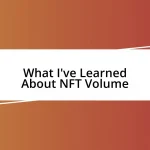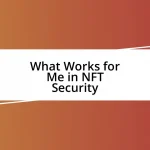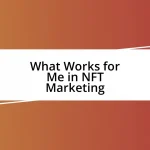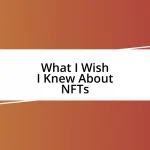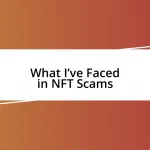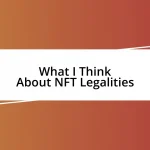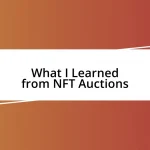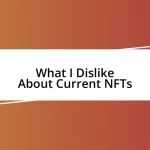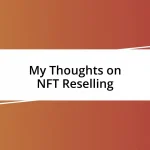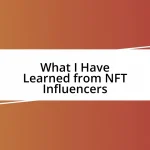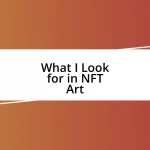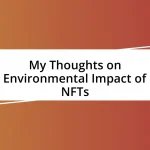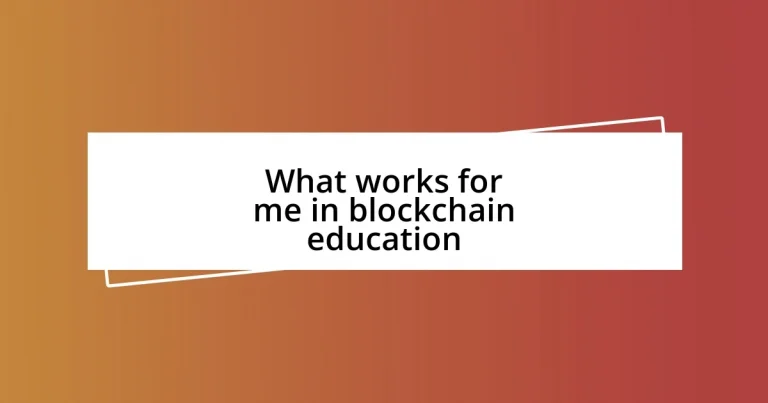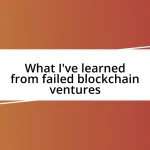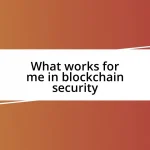Key takeaways:
- Foundational knowledge in blockchain is crucial, with concepts like decentralization, consensus mechanisms, and cryptography forming the basis for deeper understanding.
- Engaging with communities and resources, such as courses and forums, enhances learning through shared curiosity and real-world applications.
- Measuring success includes self-assessment, community engagement, and the ability to teach others, indicating a deeper grasp of blockchain concepts.
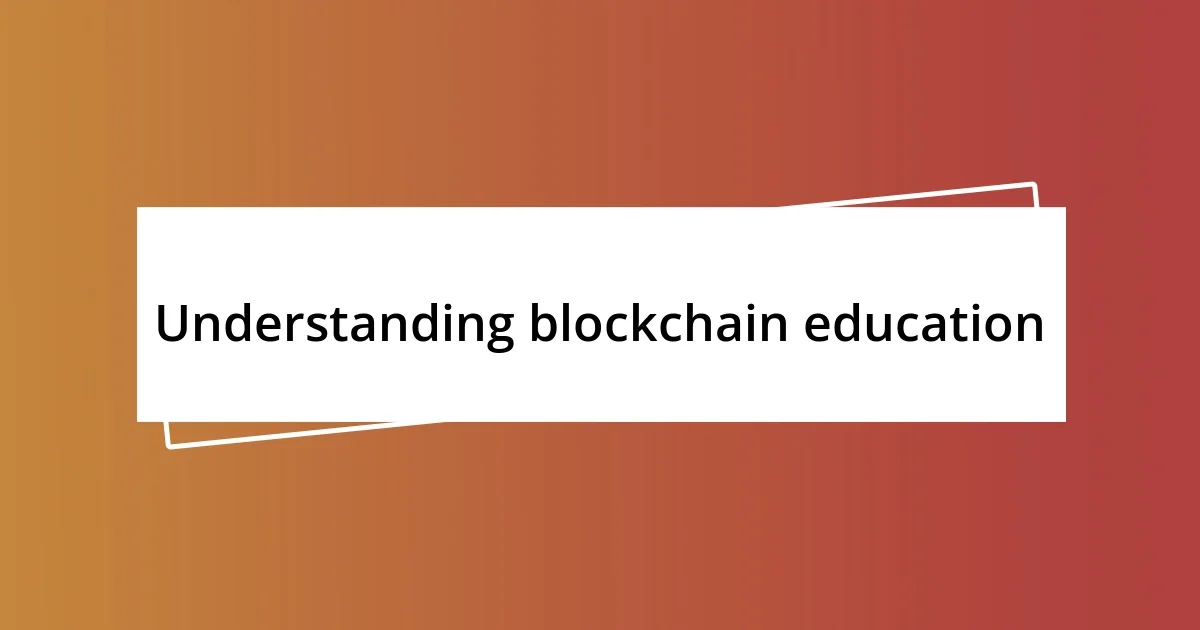
Understanding blockchain education
Blockchain education can sometimes feel like stepping into a labyrinth, right? I remember my first encounter with it—I was completely overwhelmed by the jargon. Terms like “smart contracts” and “distributed ledger technology” danced around me, and I couldn’t figure out what they really meant. This experience highlighted how critical foundational knowledge is in blockchain education.
As I delved deeper, I found that understanding the principles behind blockchain was not just about memorizing definitions; it was about grasping the underlying concepts that drive its function. For me, it became clear that visual learning tools, like infographics and videos, enhanced my comprehension. Have you ever had a “lightbulb moment” when a complex idea suddenly clicked? Those moments happened for me when I engaged with materials that illustrated how blockchain can transform industries.
Moreover, engaging with a community—whether through forums, webinars, or local meetups—was invaluable. I vividly recall discussing blockchain applications with others who were just as curious; their insights often sparked new ideas for me. This collective learning experience made the journey less daunting and more rewarding, reminding me that education thrives on shared curiosity and collaboration.
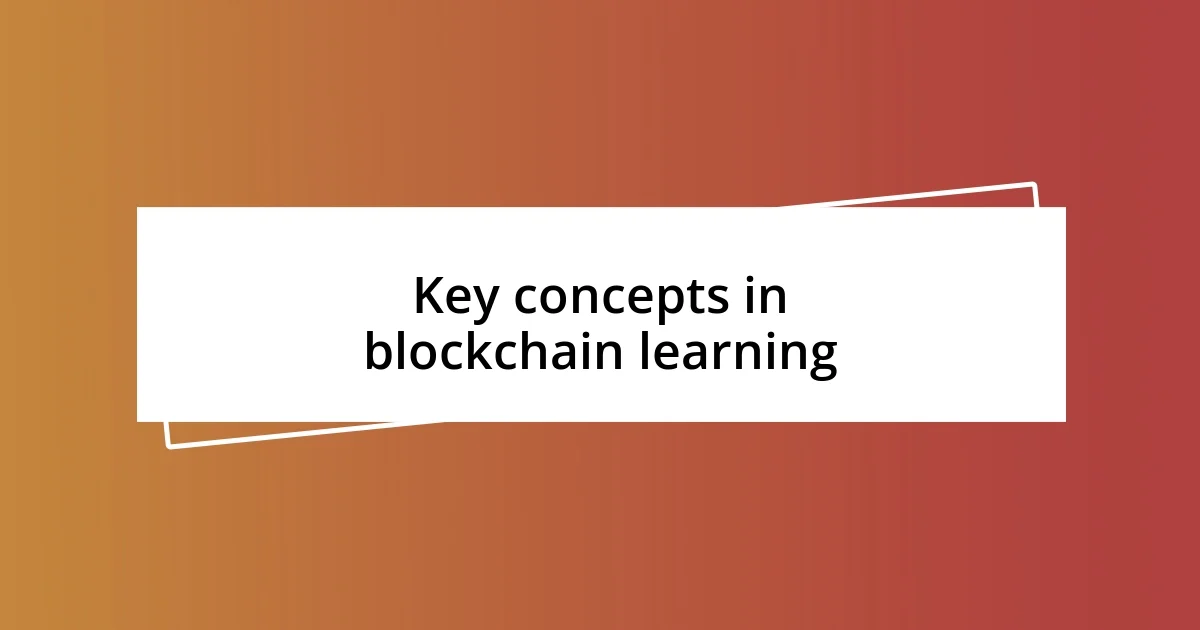
Key concepts in blockchain learning
Key concepts in blockchain learning extend beyond mere definitions; they lay the groundwork for deeper comprehension. I distinctly remember the moment I grasped how “decentralization” fundamentally changes power dynamics. It’s fascinating to see how shifting authority can benefit users. This was a true revelation for me, making me appreciate the broader implications of blockchain technology.
When exploring “consensus mechanisms,” I realized how vital they are for ensuring trust and security. The first time I dove into Proof of Work versus Proof of Stake, I felt like I was unlocking the secrets to the entire system. Understanding these mechanisms helps demystify how transactions are validated, which can be incredibly empowering. Have you ever unlocked a new layer of understanding that made everything else clearer? That’s how I felt.
Another important concept is “cryptography,” which underpins blockchain’s security features. Initially, I found cryptography to be intimidating, almost like a different language. However, as I worked through practical examples, like how hashing works to secure data, I started to see its elegance. This transformation from confusion to clarity is what keeps me engaged in blockchain education, helping me appreciate its complexities in a tangible way.
| Key Concept | Description |
|---|---|
| Decentralization | Redistribution of authority, promoting user empowerment and trust. |
| Consensus Mechanisms | Methods that ensure agreement on transaction validity; critical for blockchain integrity. |
| Crytography | Techniques that secure data and transactions, enhancing privacy and trust. |
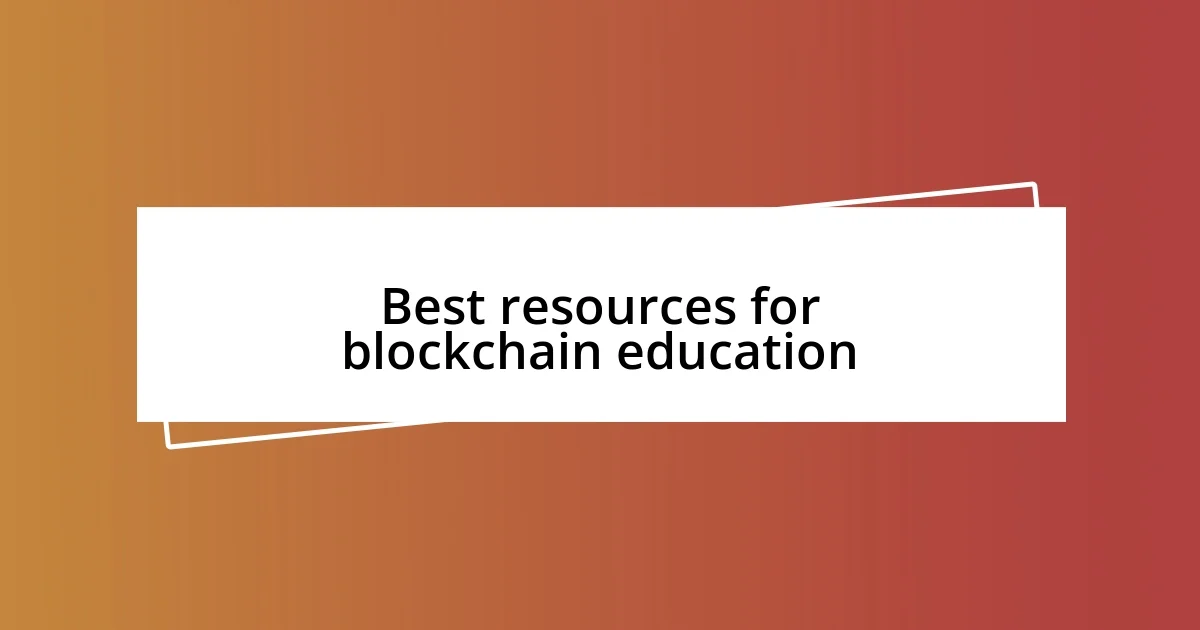
Best resources for blockchain education
When I was navigating the sea of blockchain education resources, I quickly discovered several gems that truly made a difference. Platforms like Coursera and Udemy opened my eyes to structured courses that transformed abstract concepts into digestible lessons. I remember completing an interactive project on Ethereum, which not only solidified my understanding but also fueled my passion for developing real-world applications. Engaging with these resources has been like having a personal mentor guiding me through the complexities of blockchain.
Here’s a list of some of the best resources I’ve found invaluable in my blockchain education journey:
- Coursera: Offers a variety of courses from beginner to advanced, often featuring insights from industry leaders.
- Udemy: Hosts numerous courses that include hands-on projects, which helped me apply what I learned in practical scenarios.
- YouTube: Channels like Simply Explained or 99Bitcoins provide bite-sized info that makes tough concepts enjoyable.
- Blockchain.info: An excellent source for understanding detailed blockchain transactions and real-time data.
- Books: Titles like “Mastering Bitcoin” by Andreas Antonopoulos provided a deep dive into technical details while being accessible for non-experts.
One resource that particularly stood out for me was the “Blockchain Basics” book. I remember cozying up on a rainy afternoon and losing myself in the chapters. The way it broke down complex topics into relatable examples made me feel as if I had a friend explaining this fascinating technology. This emotional connection to the material encouraged me to keep pushing my boundaries and explore more advanced topics. Resources that resonate on a personal level can make the learning process not just informative but genuinely enjoyable.
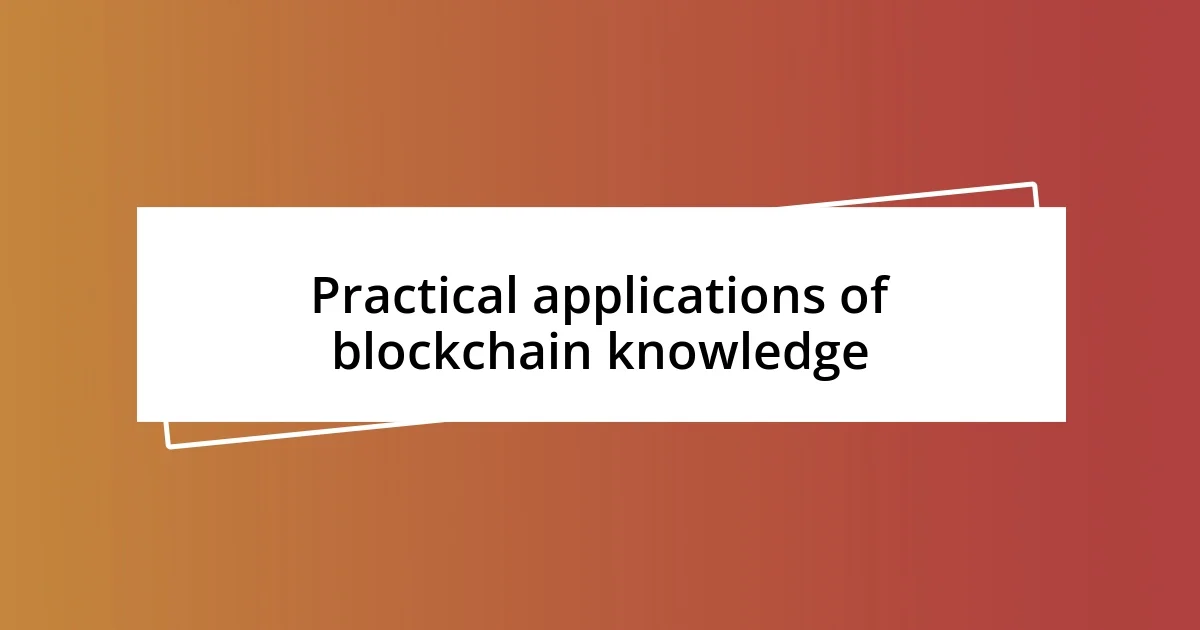
Practical applications of blockchain knowledge
Understanding the practical applications of blockchain knowledge can be a game-changer. For instance, during a hackathon, I had the opportunity to develop a smart contract using Ethereum. It felt exhilarating to see how the code could automate transactions without a middleman. This hands-on experience made the technology’s potential so much clearer, showing me just how vital blockchain could be in streamlining processes across industries.
Another aspect I find incredibly valuable is how blockchain knowledge can enhance transparency in supply chains. I remember a project where a local organic farm implemented blockchain to prove the origin of their produce. Seeing how consumers could trace their food back to its source was enlightening—it made me realize how trust could be built just by leveraging this technology. Have you ever thought about how something seemingly simple like a purchase could benefit from a transparent ledger?
Moreover, blockchain’s role in the realm of digital identity has captured my attention. One day, while attending a webinar, I learned about initiatives using blockchain to secure personal data, allowing users to control their identities online. Reflecting on my own experiences with data breaches, this felt like a significant step toward empowering individuals. It’s amazing how blockchain can not only enhance security but also restore control to users, making the digital world a safer space.
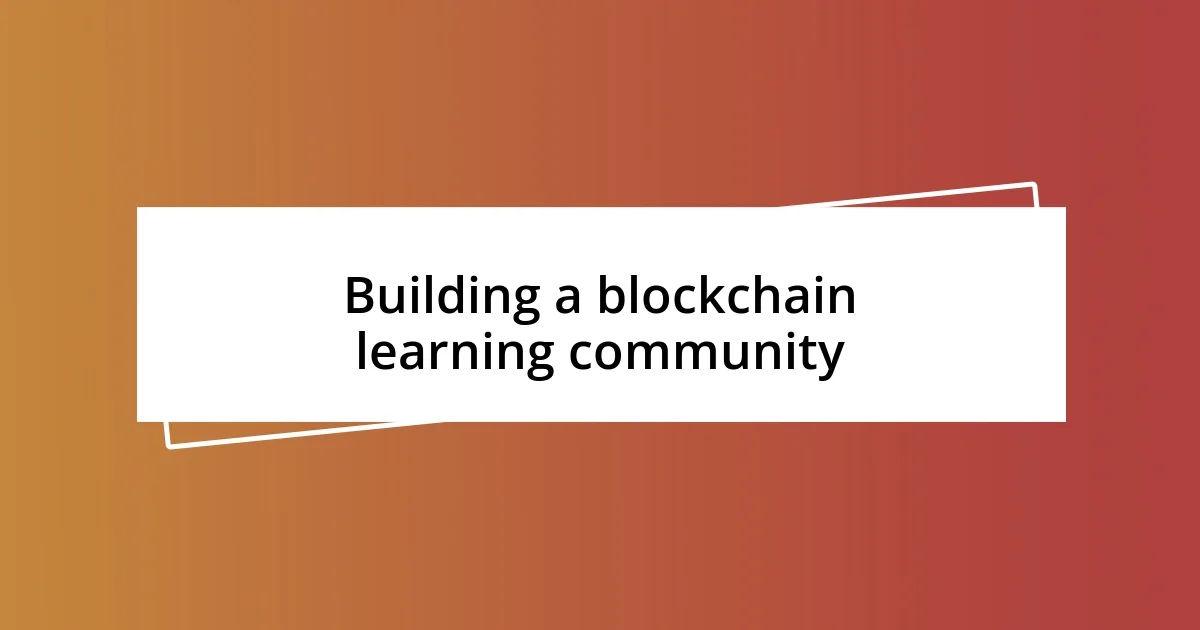
Building a blockchain learning community
Building a blockchain learning community is essential for fostering a supportive environment where everyone can grow together. I recall joining an online forum dedicated to blockchain discussions, where individuals from diverse backgrounds shared their insights and experiences. The warmth of that community inspired me to ask questions I wouldn’t have dared pose in a classroom setting, helping me grasp complicated topics with greater ease.
Participating in local meetups was another invaluable experience. I remember attending a session where industry experts spoke passionately about their projects. The energy in the room was palpable, and it was exhilarating to engage in discussions where ideas flowed like the drinks at the bar. Those connections not only helped me form friendships but also created a network of mentors who were keen to guide newcomers through the labyrinth of blockchain.
Have you ever experienced the power of teaching others to reinforce your own understanding? I started volunteering to mentor beginners in a local blockchain group, and it was a transformative experience. Watching their excitement as they overcame hurdles reminded me why I fell in love with this technology in the first place. Sharing knowledge creates a cycle of learning that elevates everyone involved, and that’s what makes building a community around blockchain so compelling.
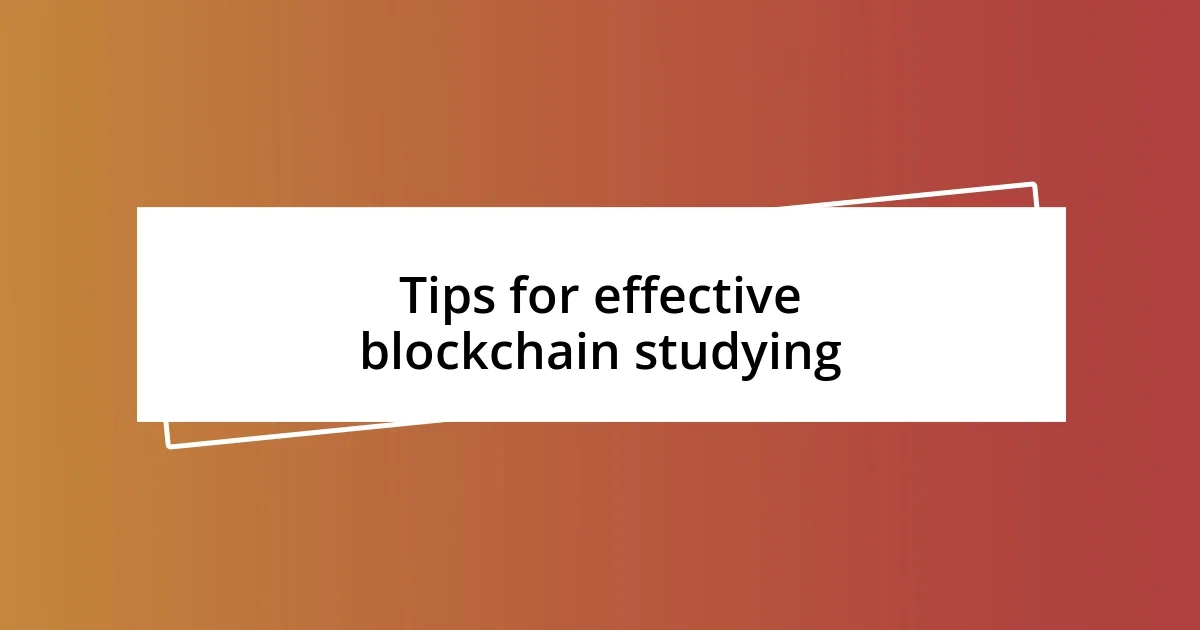
Tips for effective blockchain studying
When studying blockchain, it’s crucial to break down complex concepts into smaller, manageable pieces. I often find myself taking a deep dive into one specific area, like consensus mechanisms or tokenomics, instead of trying to understand everything at once. This focused approach not only makes the content easier to digest, but it also allows me to form stronger connections between the concepts.
Another effective tip is to leverage a variety of learning resources. Podcasts, online courses, and blockchain-themed YouTube channels have been invaluable for me. I remember discovering a podcast where industry leaders shared their insights; it was like sitting in on a casual coffee chat filled with expert opinions. Have you ever considered how different perspectives can enrich your understanding? Hearing various viewpoints has expanded my horizons and made me appreciate the nuances of blockchain technology.
Don’t underestimate the importance of regular practice through real-world applications. I regularly challenge myself by contributing to open-source blockchain projects or participating in online coding challenges. Even a small project, like creating a simple decentralized app or exploring a new blockchain platform, can solidify your learning. The thrill of seeing your code come to life is beyond rewarding and reinforces the concepts I’ve studied. How do you think practical experience influences your understanding of abstract theories? From what I’ve experienced, it bridges the gap between knowledge and practical application beautifully.
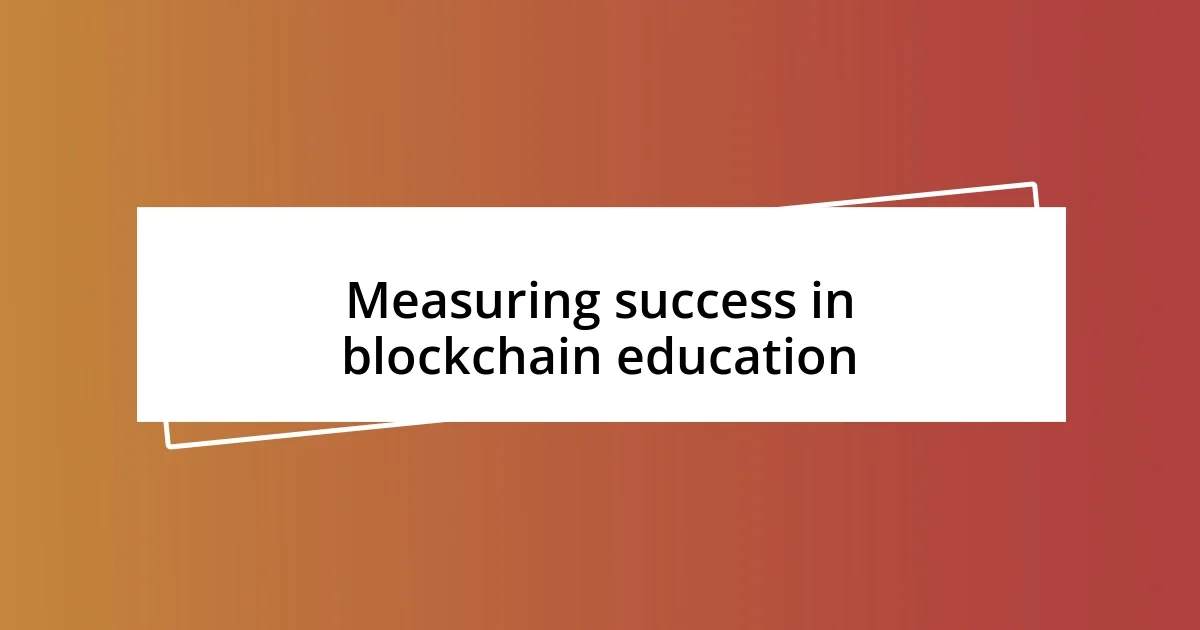
Measuring success in blockchain education
Tracking progress in blockchain education can take many forms, and I’ve found that self-assessment is invaluable. I remember setting aside time each month to evaluate what I learned and how it applied to real-world scenarios. This practice not only highlighted my growth but also allowed me to identify gaps in my understanding. Have you ever paused to reflect on your learning journey? That moment of introspection can be incredibly enlightening.
Another way to measure success is through community engagement. After attending various blockchain events, I started keeping a journal to jot down new ideas and concepts sparked by conversations with peers. This simple act turned into a powerful gauge for my learning—if I was continuously inspired to write and seek out further discussions, I knew I was on the right track. Isn’t it interesting how the act of sharing and discussing can serve as a litmus test for our understanding?
Lastly, I noticed that my ability to explain blockchain concepts to others became a yardstick for my success. When I first began learning, it felt daunting to simplify these intricate ideas. But as I grew more competent, friends and colleagues began to ask me questions. The joy of being able to break down complex topics into easy-to-understand explanations was a clear sign that I had internalized the material. How often do you find yourself in a position to teach others? In my experience, that’s one of the most rewarding metrics of success in any educational endeavor, especially in the ever-evolving field of blockchain.
